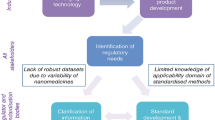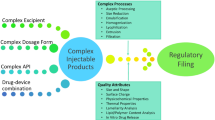Abstract
The aim of the present investigation is to systematically optimize and develop microemulsion preconcentrates to improve the solubility and oral bioavailability profile of canagliflozin employing D-optimal mixture design. Preconcentrate constituents, i.e. oils, surfactants and co-surfactants were selected on the basis of solubility studies and their concentration range capable of influencing the formation of microemulsions was determined. D-optimal mixture design was employed for studying the interaction behavior of desired responses and optimized using desirability approach. The optimized formulation was evaluated for its in vitro, ex vivo and in vivo behavior to determine the dissolution rate, permeation rate and oral bioavailability of the drug. The optimized formulation containing Lauroglycol FCC (80 mg), Tween 80 (300 mg) and Transcutol P (120 mg) showed desired attributes of measured responses with minimum experimental variation and desirability value of 0.751. The morphological behavior showed uniform nano-structured globules with negligible aggregation as confirmed in transmission electron microscopy. Ex vivo permeation rate of the drug across excised intestinal segments (duodenum, jejunum, ileum and colon) was observed to be 3.51, 5.62, 4.52 and 2.98 folds higher, respectively, as compared to drug powder and marketed tablets Compared with the pure drug and commercial tablets, enhanced in vitro dissolution rate of optimized formulation was observed, resulting in 2.56 fold enhancement in Cmax and AUC0–24h following oral administration in fasting wistar rats. Establishment of level A IVIVC for the developed SMEDDS indicated excellent goodness of fit between the in vitro drug release and in vivo drug absorbed. Accelerated stability studies indicated stability of the optimized formulation over 3 months storage.






Similar content being viewed by others
References
Amos A, McCarty D, Zimmet P (1997) The rising global burden of diabetes and its complications, estimates and projections to the year. Diabet Med 14:S1–S85
Bachhav YG, Patravale VB (2009) SMEDDS of glyburide: formulation, in vitro evaluation and stability studies. AAPS Pharm Sci Tech 10(2):482–486
Baek MK, Lee JH, Cho YH, Kim H, Lee GY (2013) Self-microemulsifying drug delivery system for improved oral bioavailability of pranilukast hemihydrate: preparation and evaluation. Int J Nanomed 8:167–176
Bakris GL, Fonseca VA, Sharma K, Wright EM (2009) Renal sodium-glucose transport: role in diabetes mellitus and potential clinical implications. Kidney Int 75(12):1272–1277
Bandyopadhyay S, Katare OP, Singh B (2012) Optimized self-nanoemulsifying systems of ezetimibe with enhanced bioavailability potential using long chain and medium chain triglycerides. Colloids Surf B 100:50–61
Barot BS, Parejiya PB, Patel HK, Gohel MC, Shelat PK (2012) Microemulsion based gel for terbinafine for the treatment of onchomycosis: optimization of formulation using D optimal mixture design. AAPS Pharm Sci Tech 13(1):184–192
Beg S, Katare OP, Saini S, Garg B, Khurana RK, Singh B (2016) Solid self-nano emulsifying systems of olmesartan medoxomil: formulation development, micromeretic characterization, in vitro and in vivo evaluation. Powder Technol 294:93–104
Berggern S, Gall C, Wollnitz N, Ekelund M, Karlbom U, Hoogstraate J, Schrenk D, Lennernas H (2007) Gene and protein expression of P-glycoprotein, MRP1, MRP2 and CYP3A4 in the small and large intestine. Mol Pharm 4(2):252–257
Burjak M, Rozman PT, Petek B, Markun B, Berjinc K, Jaklic MT, Ham JZ (2017) Pharmaceutical compositions comprising Canagliflozin. US Patent (WO 2016030502 A1)
Cerpnjak K, Zvonar A, Vrecer F, Gasperlin M (2014) Development of a solid self-microemulsifying drug delivery system (SMEDDS) for solubility enhancement of naproxen. Drug Dev Ind Pharm 41(9):1548–1557
Chaurasiya A, Singh AK, Jain G, Warsi MH, Sublet E, Ahmad FJ, Borchard G, Khar RK (2014) Dual approach utilizing self microemulsifying technique and novel P-gp inhibitor for effective delivery of taxanes. J Microencapsul 29(6):583–595
Committee for Medicinal Product for Human use, Assessment Report February (2014) http://www.ema.europa.eu/docs/en_GB/document_library/EPAR__Public_assessment_report/human/002656/WC500166672.pdf. Accessed 24 Sep 2016
Dangre P, Gilhotra R, Dhole S (2016) Formulation and statistical optimization of self-microemulsifying drug delivery system of eposartan mesylate for improvement of oral bioavailability. Drug Deliv Transl Res 6(5):610–621
Derringer G, Suich R (1980) Simultaneous optimization of several response variables. J Qual Technol 12(4):214–219
Ghai D, Sinha VR (2012) Nanoemulsions as self-emulsified drug delivery carriers for enhanced permeability of the poorly water-soluble selective β1-adrenoreceptor blocker Talinolol. Nanomed Nanotech Biol Med 8:618–662
Han DS, Jung SW, Jang SW, Son M, Kim BM, Kang MJ (2015) Reduced food effect on intestinal absorption of dronedarone by self-microemulsifying drug delivery system (SMEDDS). Biomed Pharmacother Bull 38:1026–1032
Hong EP, Kim JY, Kim SH, Hwang KM, Park CW, Lee HJ, Kim DW, Weon KY, Jeong SY, Park ES (2016) Formulation and evaluation of a self-microemulsifying drug delivery system containing bortezomib. Chem Pharm Bull 64:1108–1117
Jankovic J, Djekic L, Dobricic V, Primorac M (2015) Evaluation of critical formulation parameters in design and differentiation of self-microemulsifying drug delivery system (SMEDDS) for oral delivery of acyclovir. Int J Pharm 456:1232–1244
Kalra S (2014) Sodium glucose co-transporter-2 (SGLT) inhibitors: a review of their basic and clinical pharmacology. Diabetes Ther 5:355–366
Kamboj S, Rana V (2016) Quality by design based development of a self-microemulsifying drug delivery system to reduce food effect of nelfinavir mesylate. Int J Pharm 501(2):311–325
Kang JH, Oh DH, Oh YK, Yong CS, Choi HG (2012a) Effects of solid carriers on the crystalline properties, dissolution and bioavailability of flurbiprofen in solid self-nanoemulsifying drug delivery system (solid-SNEDDS). Eur J Pharm Biopharm 80:289–297
Kang MJ, Kim HS, Jeon HS, Park JH, Lee BS, Ahn BY, Moon KY, Choi YW (2012b) In situ intestinal permeability and in vivo absorption characteristics of olmesartan medoximil in self-microemulsifying drug delivery system. Drug Dev Ind Pharm 38(5):587–596
Kaseem AA, Mohsen AM, Ahmed RS, Essan TM (2016) Self-nanoemulsifying drug delivery system (SNEDDS) with enhanced solubilization of nystatin for treatment of oral candidiasis: design, optimization, in vitro and in vivo evaluation. J Mol Lipids 218:219–232
Kaur I, Wakode S, Singh HP, Manachanda S (2016) Development and validation of stability indicating reverse phase HPLC-PDA method for determination of canagliflozin in bulk and pharmaceutical dosage form. Pharm Methods 7(1):54–62
Khan AW, Kotta S, Ansari SH, Sharma RK, Ali J (2014) Self-nanoemulsifying drug delivery system (SNEDDS) of the poorly water soluble grape fruit flavonoid naringenin: design, characterization. In vitro and in vivo evaluation. Drug Deliv 22:552–561
Krishnamoorthy B, Rahman HS, Selvan TN, Parsad HR, Rajkumar M, Selvakumar SM, Vamshikrishna K, Gregory M, Vijayaraghavan C (2015) Design, formulation, in vitro, in vivo and pharmacokinetic evaluation of nisoldipine loaded self-nanoemulsifying drug delivery system. J Nanopart Res 17:34–42
Ma YG, Yuan XZ, Peng X, Wang H, Huang HJ, Bao S, Huan L, Xiao ZH, Zeng GM (2015) The pseudo ternary phase diagrams and properties of anionic-nonionic mixed surfactant reverse micellar systems. J Mol Lipids 203:181–186
Narang AS, Delmarre D, Gao D (2007) Stable drug encapsulation in micelles and microemulsions. Int J Pharm 345:9–25
Nekkanti V, Wang Z, Betageri GV (2015) Pharmacokinetic evaluation of improved oral bioavailability of valsartan: proliposomes versus self-nanoemulsifying drug delivery system. AAPS Pharm Sci Tech 17(4):851–862
Prasad D, Chauhan H, Atef E (2013) Studying the effect of lipid chain length on the precipitation of poorly water soluble drug from self-emulsifying drug delivery system on dispersion into aqueous medium. J Pharm Pharmacol 65(8):1134–1144
Rege BD, Kao J, Pollia J (2002) Effect of nonionic surfactants on membrane transporters in Caco-2 cell monolayers. Eur J Pharm Sci 16:237–246
Shakeel F, Haq N, Alanazi FK, Alsarra IA (2014) Self-nanoemulsifying performance of two grades of Lauroglycol (Lauroglycol-90 and Lauroglycol-FCC) in the presence of mixed nonionic surfactants. Pharm Dev Technol 19(7):799–805
Shakeel F, Haq N, Raish M, Siddiqui NA, Alanazi FK, Alsarra IA (2016) Anti-oxidant and cytotoxic effects of vanillin via eucalyptus oil containing self-nanoemulsifying drug delivery system. J Mol Lipids 218:233–239
Singh D, Sharma K, Bedi N (2017) Tacrolimus loaded liquid and solid self-microemulsion preconcentrates: development and evaluation. Drug Deliv Lett 7(1):24–38
Sood J, Sapra B, Tiwary AK (2016) Microemulsion transdermal formulation for simultaneous delivery of valsartan and nifedipine: formulation by design. AAPS Pharm Sci Tech 18(6):1901–1916
Sun M, Zhai X, Xue K, Hu L, Yang X, Li G, Si L (2011) Intestinal absorption and intestinal lymphatic transport of sirolimus from self-microemulsifying drug delivery systems assessed using the single-pass intestinal perfusion (SPIP) technique and a chylomicron flow blocking approach: linear correlation with oral bioavailabilities in rats. Eur J Pharm Sci 43:132–140
Wu L, Qiao Y, Wang L, Guo J, Wang G, He W, Yin L, Zhao J (2015) A self-microemulsifying drug delivery system (SMEDDS) for a novel medicative compound against depression: a preparation and bioavailability study in rats. AAPS. Pharm Sci Tech 16(5):1051–1058
Yeom DW, Song SY, Kim SR, Lee SG, Kang MY, Lee S, Choi YW (2015) Development and optimization of a self-microemulsifying drug delivery system for atorvastatin calcium by using D-optimal mixture design. Int J Nanomed 10:3865–3878
Zhao G, Huang J, Xue K, Si L, Li G (2013) Enhanced intestinal absorption of etoposide by self-microemulsifying drug delivery systems: roles of P-glycoprotein and cytochrome P 450 3A inhibition. Eur J Pharm Sci 50:429–439
Acknowledgements
The authors are highly thankful to Zydus Cadila Limited, Ahmedabad for providing gift sample of canagliflozin. Emerging Life Sciences Facility in Guru Nanak Dev University for carrying out characterization studies is highly acknowledged.
Author information
Authors and Affiliations
Corresponding author
Ethics declarations
Conflict of interest
The authors declare that they have no conflict of interest.
Research involving human and animal rights
All institutional and national guidelines for the care and use of laboratory animals were followed.
Electronic supplementary material
Below is the link to the electronic supplementary material.
Rights and permissions
About this article
Cite this article
Singh, D., Tiwary, A.K. & Bedi, N. Canagliflozin loaded SMEDDS: formulation optimization for improved solubility, permeability and pharmacokinetic performance. J. Pharm. Investig. 49, 67–85 (2019). https://doi.org/10.1007/s40005-018-0385-5
Received:
Accepted:
Published:
Issue Date:
DOI: https://doi.org/10.1007/s40005-018-0385-5




